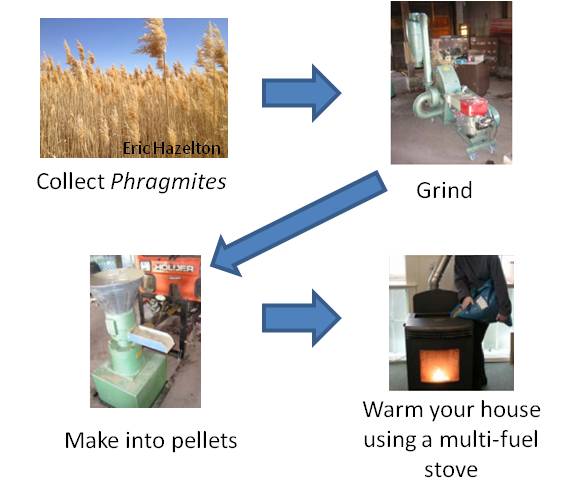by Gregory Zimmerman, Dept of Biology, Lake Superior State University
April 2013
For the past several years, our research team has been experimenting with the use of weedy grasses for making heating pellets(to be used to heat your home). The focus of the project is to find economic uses for these weedy grasses as well as reduce greenhouse gas inputs into the atmosphere and improve farm finances. The environmental benefits come from the fact that the fuel is more carbon neutral since combustion of grasses simply re-releases previous year’s CO2 taken up by the plants, so long as the harvest and fuel manufacture have minimal energy inputs. Our research suggests a 32x energy payback in fuel compared to the fuel required to harvest and process the grasses. Perennial grasses are also more environmentally benign energy sources since they require no annual tillage, thus reducing energy input and conserving soil carbon. Unlike wood sources, grasses harvested in late fall require little drying during the fuel making process which further reduces the carbon inputs into the fuel making process. Late harvests also conserve soil nutrients since the plants are harvested after translocating nutrients to the roots. The economic benefit to farms is the use of readily available fuel stock using commonly available equipment most likely already on hand, all at a savings compared to the price of propane (the most common heating fuel on farms).
The project was initiated with reed canary grass (RCG). Using a tractor PTO mounted horizontal die pelletizer, we can make nice pellets from RCG. We have been successful using spent brewer’s grain, and with a commercial binder (essentially cornstarch) and even corrugated cardboard. Other attempts at using pond algae, pine needles, and other materials were not successful.

Using Phragmites to heat your home – adapted from the Lake Superior State Poster http://www.michigan.gov/documents/dleg/LSSU_Project_Overview_299143_7.pdf
The pellets burned well in a multi-fuel pellet stove. The energy content of our RCG pellets approximates that of wood pellets (about 8000 BTU/lb) but our RCG pellets have slightly less density (lbs/ft3). Ash content is substantially greater than with wood pellets. The multifuel stove is designed to handle the excess ash.
We also made pellets from Phragmites. It makes very nice pellets, partly because the large, hollow stalk grinds up very nicely into uniform sized particles that feed into the pellet mill better than the mix of stems and leaves in the reed canary grass. We made pellets from giant miscanthus provided from some decorative planting here in the Sault. Miscanthus made satisfactory pellets. As part of the project, we’re also looking at switchgrass as a feed stock. We found that switchgrass pellets were no better than reed canary grass and not as nice as Phragmites.
We are not advocating planting of reed canary grass, giant miscanthus or Phragmites, only to use existing stands. Harvesting RCG in late fall probably will not reduce stand density or extent but at least it’s getting some economic value from an otherwise less valuable resource. We are interested to see whether removing standing biomass of Phragmites might reduce its success by opening the canopy for native plants.
We have been harvesting small quantities of Phragmites manually. We plan to develop a battery operated harvester to save some effort and to develop a harvesting process to increase efficiency of hand harvesting. Regardless of how efficient we can make hand harvesting, any substantial harvest will need to be mechanized. Mechanical harvesting of Phragmites that makes both economic sense and is compatible with wetland conservation will require further research.
We are interested in talking to the Phragmites control community about harvest techniques and to see how we could help people make use the material presently being burned or composted perhaps even in a way that could generate revenue for Phragmites control efforts.
We are presently trying to scale up our production from benchtop demo quantities to a few tons, the amount of pellets required to heat a home for the winter. More information is available about our reed canary grass pellet research from http://www.michigan.gov/documents/dleg/ReedCanaryGrassReport_243249_7.pdf
